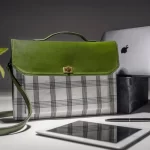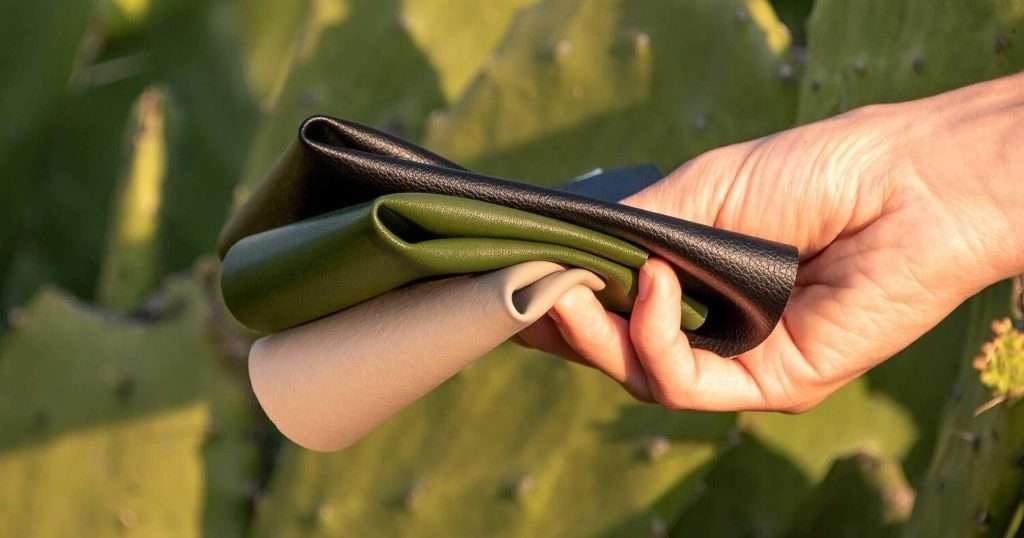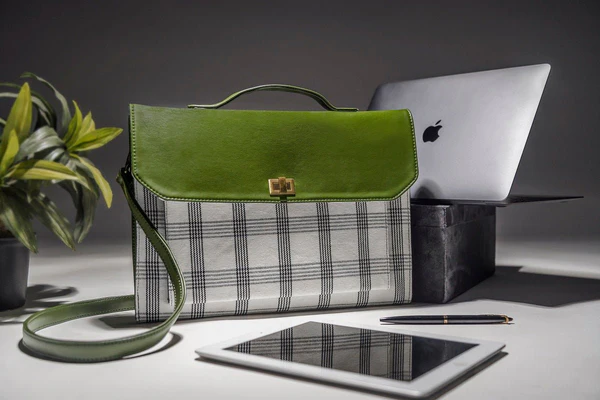Leather Made From Plants
| Heading | Subheading |
|---|---|
| 1. Introduction | – What is plant-based leather? |
| – Importance of sustainable materials | |
| 2. History | – Origins of plant-based leather |
| – Evolution over the years | |
| 3. Types | – Different types of plant-based leather |
| – Advantages and disadvantages | |
| 4. Manufacturing | – Process of creating plant-based leather |
| – Sustainable practices involved | |
| 5. Environmental Impact | – Comparison with traditional leather |
| – Reduction of carbon footprint | |
| 6. Popular Brands | – Leading companies in plant-based leather |
| – Innovation and trends | |
| 7. Fashion Industry | – Adoption of plant-based leather in fashion |
| – Design versatility and trends | |
| 8. Automotive Industry | – Applications in car interiors |
| – Durability and performance | |
| 9. Furniture Industry | – Use in furniture manufacturing |
| – Comfort and aesthetics | |
| 10. Future Prospects | – Growth potential of plant-based leather |
| – Technological advancements | |
| 11. Consumer Awareness | – Educating consumers about plant-based leather |
| – Changing consumer preferences | |
| 12. Challenges | – Obstacles in widespread adoption |
| – Solutions and innovations | |
| 13. Ethical Considerations | – Animal welfare and ethics |
| – Labor practices | |
| 14. Global Impact | – Contribution to sustainability goals |
| – Influence on global markets | |
| 15. Conclusion | – Recap of benefits |
| – Looking ahead to a greener future |
Leather Made From Plants
Introduction
The fashion industry is undergoing a remarkable transformation, driven by a growing consciousness towards sustainability. Among the innovative solutions emerging in this shift is the concept of plant-based leather. Let’s delve into this revolutionary material that is not only eco-friendly but also stylish and versatile.
What is plant-based leather?
Plant-based leather, also known as vegan leather or faux leather, is a sustainable alternative to traditional animal leather. Unlike animal leather, which is derived from the skin of animals like cows, goats, or sheep, plant-based leather is crafted from natural materials such as pineapple leaves, cork, apple peels, and mushrooms. This eco-conscious approach eliminates the need for animal farming and reduces environmental harm.
Importance of sustainable materials
In an era marked by climate change and environmental degradation, the quest for sustainable materials has become paramount. Plant-based leather offers a compelling solution by reducing reliance on animal agriculture, which is a significant contributor to deforestation, greenhouse gas emissions, and water pollution. By embracing plant-based alternatives, we can mitigate our ecological footprint and pave the way for a greener future.
History
The roots of plant-based leather trace back to ancient civilizations, where indigenous cultures utilized plant fibers and extracts to craft durable textiles and garments. However, it wasn’t until recent years that modern technology enabled the production of high-quality plant-based leather on a commercial scale.
Origins of plant-based leather
The concept of plant-based leather gained traction in the early 21st century as concerns over animal welfare and environmental sustainability surged. Innovators began experimenting with various plant-derived materials, seeking to replicate the look, feel, and durability of traditional leather without harming animals or the planet.
Evolution over the years
Over the years, plant-based leather has undergone significant evolution, spurred by advancements in biotechnology, material science, and sustainable practices. From early prototypes with limited durability and aesthetic appeal, plant-based leather has evolved into a diverse range of innovative materials that rival traditional leather in quality and performance.
Types
Plant-based leather encompasses a wide range of materials, each with its unique properties and applications. Let’s explore some of the most popular types and their advantages and disadvantages.
Different types of plant-based leather

- Pineapple Leather: Made from pineapple leaf fibers, this material is durable, lightweight, and biodegradable. It offers a cruelty-free alternative to traditional leather and is commonly used in fashion accessories and footwear.
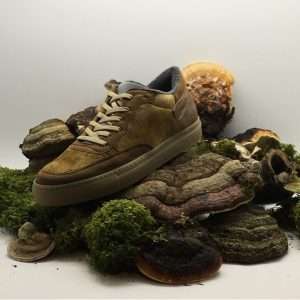
- Mushroom Leather: Also known as Mycelium leather, this material is derived from fungal mycelium grown on agricultural waste. It boasts a soft, suede-like texture and is gaining popularity in the fashion industry for its sustainability and versatility.
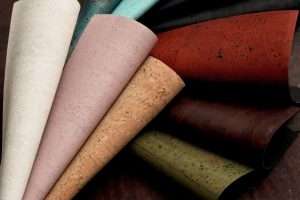
- Cork Leather: Harvested from the bark of cork oak trees, cork leather is lightweight, water-resistant, and hypoallergenic. It is often used in accessories, upholstery, and interior design for its natural beauty and durability.

- Apple Leather: Utilizing apple pomace, a byproduct of apple juice production, apple leather offers a cruelty-free alternative with a unique texture and appearance. It is particularly popular in the production of wallets, bags, and phone cases.
Advantages and disadvantages
Advantages
- Sustainability: Plant-based leather reduces reliance on animal agriculture and minimizes environmental impact.
- Versatility: It can be crafted into various textures, colors, and finishes, offering endless design possibilities.
- Cruelty-free: No animals are harmed in the production process, aligning with ethical and animal welfare principles.
Disadvantages
- Cost: Plant-based leather may be more expensive to produce than traditional leather due to the use of innovative materials and manufacturing processes.
- Durability: While advancements have improved durability, some plant-based leathers may still lack the longevity of traditional leather.
- Limited availability: Despite growing demand, plant-based leather is not yet as readily available as traditional leather, limiting its widespread adoption.
Manufacturing
The process of creating plant-based leather involves innovative techniques that harness the natural properties of plant materials while minimizing environmental impact.
Process of creating plant-based leather
- Extraction: Plant fibers or extracts are harvested from sustainable sources, such as pineapple leaves or mushroom mycelium.
- Processing: The raw materials undergo processing to extract fibers or create a suitable base for leather production.
- Tanning: Unlike traditional leather, which often involves toxic chemicals, plant-based leather is tanned using eco-friendly methods such as vegetable tanning or enzymatic processes.
- Finishing: The leather is dyed, treated, and finished to achieve the desired texture, color, and durability.
Sustainable practices involved
- Resource optimization: Plant-based leather utilizes renewable resources and agricultural byproducts, minimizing waste and environmental impact.
- Energy efficiency: Manufacturers employ energy-efficient processes and renewable energy sources to reduce carbon emissions.
- Closed-loop systems: Some companies implement closed-loop systems that recycle water, chemicals, and materials to minimize resource consumption and waste generation.
Environmental Impact
The environmental impact of plant-based leather is significantly lower compared to traditional leather, making it a more sustainable choice for environmentally-conscious consumers.
Comparison with traditional leather
Traditional leather production is associated with deforestation, water pollution, and greenhouse gas emissions from animal agriculture. In contrast, plant-based leather reduces the demand for animal farming and minimizes environmental harm.
Reduction of carbon footprint
By utilizing plant materials and eco-friendly manufacturing processes, plant-based leather helps mitigate carbon emissions and combat climate change. Additionally, the biodegradable nature of many plant-based leathers reduces waste and promotes circularity in the fashion industry.
Popular Brands
Several leading companies are spearheading the adoption of plant-based leather, offering stylish and sustainable alternatives to traditional leather products.
Leading companies in plant-based leather
- Pinatex: Known for its pineapple leather, Pinatex collaborates with fashion brands worldwide to create eco-friendly accessories and footwear.
- Bolt Threads: This innovative company specializes in Mylo, a mushroom-based leather that combines sustainability with luxury and performance.
- Corkor: Corkor produces a range of accessories and bags made from high-quality cork leather, showcasing the natural beauty and versatility of this material.
Innovation and trends
As consumer demand for sustainable products continues to rise, companies are investing in research and development to enhance the quality and performance of plant-based leather. From biodegradable finishes to 3D printing technology, the future of plant-based leather holds promise for innovation and sustainability.
Fashion Industry
The fashion industry is embracing plant-based leather as a chic and ethical alternative to traditional leather, driving trends towards eco-friendly and cruelty-free fashion.
Adoption of plant-based leather in fashion
Fashion designers and brands are increasingly incorporating plant-based leather into their collections, showcasing the versatility and aesthetic appeal of sustainable materials. From luxury handbags to vegan leather jackets, plant-based leather offers endless possibilities for eco-conscious consumers.
Design versatility and trends
Plant-based leather can be dyed, embossed, and manipulated to create a wide range of textures and finishes, making it a versatile choice for fashion designers. Trends such as minimalist aesthetics and nature-inspired motifs complement the natural beauty of plant-based leather, further fueling its popularity in the fashion world.
Automotive Industry
Beyond fashion, plant-based leather is making inroads into the automotive industry, offering car manufacturers a sustainable and stylish option for vehicle interiors.
Applications in car interiors
Car seats, dashboards, and interior trims made from plant-based leather provide a luxurious and eco-friendly alternative to traditional materials. Automakers are increasingly incorporating plant-based leather into their designs to appeal to environmentally-conscious consumers and meet sustainability targets.
Durability and performance
Plant-based leather offers durability and performance comparable to traditional leather, making it a practical choice for automotive applications. With proper care and maintenance, plant-based leather upholstery can withstand the rigors of daily use while reducing environmental impact.
Furniture Industry
In the realm of interior design, plant-based leather is redefining luxury and sustainability in furniture manufacturing.
Use in furniture manufacturing
From sofas and chairs to ottomans and headboards, plant-based leather adds a touch of elegance and eco-friendliness to furniture design. Its soft texture, durability, and hypoallergenic properties make it an ideal choice for upholstery in residential and commercial settings.
Comfort and aesthetics
Plant-based leather offers the luxurious feel of traditional leather without the ethical or environmental drawbacks. Its natural variations and textures lend a sense of authenticity and warmth to furniture pieces, elevating the aesthetic appeal of any space.
Future Prospects
The future of plant-based leather is brimming with potential, driven by technological advancements, shifting consumer preferences, and sustainability imperatives.
Growth potential of plant-based leather
As awareness of environmental issues grows and regulatory pressures mount, the demand for sustainable materials like plant-based leather is expected to soar. Companies that invest in research, innovation, and supply chain transparency stand to capitalize on this burgeoning market and drive positive change in the fashion and manufacturing industries.
Technological advancements
Advancements in biotechnology, material science, and manufacturing processes are fueling the development of new and improved plant-based leather materials. From biofabrication to nanotechnology, scientists and engineers are exploring innovative solutions to enhance the performance, durability, and aesthetics of plant-based leather, paving the way for a more sustainable future.
Consumer Awareness
Educating consumers about the benefits of plant-based leather is essential to driving widespread adoption and fostering a culture of sustainability.
Educating consumers about plant-based leather
Through marketing campaigns, educational initiatives, and transparent labeling, companies can raise awareness about the environmental and ethical advantages of plant-based leather. By empowering consumers to make informed choices, we can create a demand for sustainable products and encourage industry-wide adoption of eco-friendly materials.
Changing consumer preferences
Millennials and Gen Z consumers, in particular, are driving demand for sustainable and ethical products, prompting brands to prioritize transparency, authenticity, and sustainability in their offerings. As consumer preferences continue to evolve, plant-based leather is poised to become a mainstream choice for fashion, automotive, and furniture industries.
Challenges
Despite its promise, the widespread adoption of plant-based leather faces several challenges that must be addressed to unlock its full potential.
Obstacles in widespread adoption
- Cost barriers: Plant-based leather production may be costlier than traditional leather, making it less accessible to mass-market consumers.
- Supply chain complexities: Sourcing sustainable materials and ensuring ethical labor practices throughout the supply chain present logistical challenges for manufacturers.
- Perception and misconceptions: Some consumers may harbor misconceptions about the quality, durability, and performance of plant-based leather, hindering widespread acceptance.
Solutions and innovations
To overcome these challenges, stakeholders must collaborate to drive innovation, improve supply chain transparency, and educate consumers about the benefits of plant-based leather. By fostering a supportive ecosystem of manufacturers, retailers, and consumers, we can accelerate the transition to a more sustainable and ethical future.
Ethical Considerations
Plant-based leather offers a compelling solution to ethical concerns associated with traditional leather production, including animal welfare and labor practices.
Animal welfare and ethics
By eliminating the need for animal farming and slaughter, plant-based leather spares countless animals from suffering and exploitation. It aligns with ethical principles of compassion and respect for all living beings, offering consumers a guilt-free alternative to traditional leather products.
Labor practices
Ensuring ethical labor practices throughout the supply chain is essential to the integrity and sustainability of plant-based leather production. From fair wages and safe working conditions to transparent sourcing and production processes, companies must uphold high standards of social responsibility to safeguard the well-being of workers and communities.
Global Impact
The adoption of plant-based leather has far-reaching implications for sustainability, innovation, and economic development on a global scale.
Contribution to sustainability goals
Plant-based leather contributes to a range of sustainability goals, including reducing carbon emissions, conserving natural resources, and promoting biodiversity. By shifting away from animal agriculture and embracing renewable materials, we can mitigate climate change and preserve ecosystems for future generations.
Influence on global markets
As consumer demand for sustainable products grows, plant-based leather is poised to disrupt global markets and reshape industries ranging from fashion and automotive to furniture and beyond. Its versatility, performance, and eco-friendly credentials position plant-based leather as a catalyst for positive change in the global economy, driving innovation, and sustainability across sectors.
Conclusion
In conclusion, plant-based leather represents a paradigm shift in the fashion and manufacturing industries, offering a sustainable, ethical, and stylish alternative to traditional leather. From pineapple leaves to mushroom mycelium, innovative materials and technologies are revolutionizing the way we think about leather, paving the way for a greener, more compassionate future.
FAQs (Frequently Asked Questions)
- Is plant-based leather as durable as traditional leather? Plant-based leather has made significant advancements in durability and performance, with many materials offering comparable strength and longevity to traditional leather.
- Are plant-based leather products more expensive? Due to the innovative materials and manufacturing processes involved, plant-based leather products may be slightly more expensive than their traditional counterparts. However, prices are expected to decrease as technology advances and demand grows.
- How do I care for plant-based leather products? Plant-based leather products can be cared for in much the same way as traditional leather. Regular cleaning and conditioning with suitable products will help maintain their appearance and extend their lifespan.
- Are there any environmental benefits to using plant-based leather? Yes, plant-based leather offers several environmental benefits, including reduced carbon emissions, conservation of natural resources, and decreased reliance on animal agriculture, which is a major contributor to deforestation and greenhouse gas emissions.
- What are some common misconceptions about plant-based leather? Some common misconceptions about plant-based leather include concerns about durability, performance, and appearance. However, advancements in technology and manufacturing have addressed many of these concerns, making plant-based leather a viable alternative to traditional leather.
Do Follow Us On Twitter – https://twitter.com/Uniqverses708
We Have a Wide Range of Unique information For You On Uniqverses.com
Please like, comment & Share if you want us to keep bringing these amazing and unique information for you.


